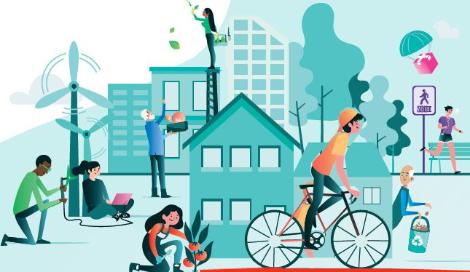Tomorrow my territory 13 Moving around by innovating within the territories
Rural mobility
November 2019
Agence pour l’Environnement et la Maîtrise de l’Energie (ADEME)
The 20 factsheets in the collection « demain MON TERRITOIRE » have been designed to give candidates and elected officials practical keys to take action, to open up the field of possibilities based on the experiences of other elected officials, from small towns to conurbations, large urban areas or sparsely populated areas. In the four corners of France, both in metropolitan France and in the French Overseas Territories, many of them are taking action, together with the players in their territories, to prepare for the future by taking action to mitigate climate change and adapt to its effects. With its knowledge and presence throughout the country, ADEME supports them with its tools, activities and financial aid.

Why is it important to imagine alternative modes of transport in rural and peri-urban areas?
Moving around by innovating within territories The spread of urban areas and the dispersal of housing in rural areas, the location of economic activities and the lack of public transport in these territories where 40% of the French live, have led to massive use of the private car, which is no longer sustainable today both for the climate, air quality and the purchasing power of the inhabitants of peripheral and rural areas, who are forced to use their vehicle on a daily basis. Local authorities, in association with private or associative actors, must now propose and encourage alternative ways of getting around that are less polluting for the environment and less costly for their budget. It is a question of maintaining social links and access to services: health, education, shops, leisure activities, etc. It is also an asset to strengthen the attractiveness of their territory.
How do you do it?
-
Knowledge of regular travel practices in the catchment area is necessary to develop a new mobility policy adapted to needs. A survey is conducted on the habits of residents and their socio-economic profile, the geography of the territory and its poles of activity. We identify « white zones » and sources of dissatisfaction with existing transportation services. A diagnosis is made and experiments are launched.
-
The future lies in shared mobility. It is being encouraged by setting up carpooling areas along busy roads and creating a platform to connect drivers and passengers. A car-sharing service is being organized to facilitate car rentals from one person to another. A service that can be duplicated within the companies in an activity zone. We stimulate safe hitchhiking with road signs.
-
We facilitate bike/train intermodality with secure parking facilities.
-
The circulation of low-emission vehicles is supported by installing recharging stations for electric cars and/or refuelling points for gas-powered ones. The community also invests in a fleet of electric or gas-powered vehicles and can mutualize their use, for example by offering residents the option of using the vehicles when staff are not using them.
-
Traditional or electric, the bicycle is a good mode of travel, including in rural and peri-urban areas. Within the intermunicipal system or in conjunction with the surrounding communes, measures are being taken to develop it. With cycle routes and greenways, secure car parks, a fleet of self-service electric bicycles, a repair service, etc., the city is taking steps to develop this mode of transport.
-
Bike » or « paediatric bus » routes are secured so that children can cycle or walk to school.
-
Emphasis is placed on a transport service on demand, at reasonable fares, allowing travel for modest households, young people, people with reduced mobility and even tourists.
-
Merchants are being mobilized to become « parcel relays » in order to simplify the « last kilometre » of delivery.
-
Consideration is being given to the installation of « third party locations » for teleworking or videoconferencing meetings.